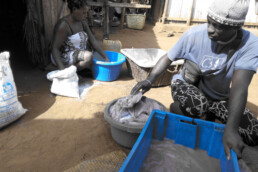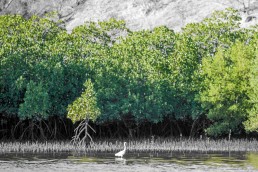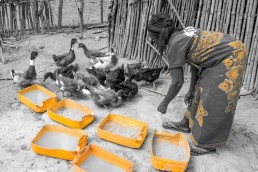IUCN BIOPAMA
IUCN BIOPAMA


Strengthening the co-management of Nosy Hara Marine National Park
Our project with IUCN BIOPAMA strengthens the co-management of Nosy Hara Marine National Park to ensure sustainable management of marine resources and increase the resilience of local communities to climate change.
Implemented in Nosy Hara National Marine Park in the Diana Region of Madagascar, our project runs from January 2023 to June 2024.
We address the following BIOPAMA AC objectives:
- Enhance the management and governance of priority areas by addressing existing limitations;
- Enforce the legal framework required to achieve effective biodiversity conservation in protected areas;
- Support local communities’ initiatives aiming to enhance the livelihoods of local people whilst effectively contributing to protected areas’ management
We also address the following priority needs:
- Lack of surveillance against illegal mangrove harvesting
- Lack of habitat restoration activities (mangroves)
- Illegal catch of octopus and crab leading to a decrease of 20% in annual yield since 2018 – this situation is urgent, especially in specific communities. The basis of concern for management is a knowledge of life cycles, ecology, threats and sustainable harvesting techniques as well as abiding by closed periods, and maximising the yields and profits through improvements in harvest, handling, storage and transport for sale.
- Lack of public outreach and education about the park, the marine systems and regulations much has been done on the level of individual villages, but this will be the first time all 21 villages are impacted as well as news disseminated nationally and internationally via traditional media (radio, film) and social media (website, Facebook, Twitter, BIOPAMA portal).
- Lack of monitoring and surveillance equipment for CLPs
One of the key drivers for the first two problems, is the immigrant fishers from the Nosy Be region coming to exploit Park resources illegally compounded by the limited capacity of CLPs for surveillance and enforcement. This project will ensure wide scale registration of legal fishers with issuance of identification cards to ensure that enforcement is facilitated.
Currently the CLP representatives on the CBO do not even have a list of current CLP members in their own communities. It is therefore urgent to set up a simple and effective database system that is sustainable and transparent.
-
- Type of priority area:
-
- Marine Protected Area
- Marine Managed areas
- Key Biodiversity Area
-
- Primary objective:
- Governance
- Management Effectiveness
- Livelihoods
- Primary objective:
-
- Target groups:
- Local communities
- Youth
- Women
- Farmers/Fishermen
- Target groups:
-
- Main activity focus:
- Sustainable development
- Ecosystem/habitat restoration
- Capacity building
- Main activity focus:
- Awareness/education:
- Monitoring/Patrol equipment
These are the outcomes of our project with IUCN BIOPAMA.
Outcome 1 :
- Increased management effectiveness of Park through capacity building of CLPs and MNP rangers
- There will be 300 active and capable members of CLP across the 21 Park villages, including 23% women.
- CBO capacity built for project management and independent financial management and reporting.
- A capable CLP team, 10 per village, aware of basics of marine ecology, threats, conservation and monitoring.
Outcome 2:
- Increased awareness of Park laws and regulations within and outside the Park to increase compliance
- 6,000+ people aware of the Park and its values and regulations
- Public awareness increases by 50% about the importance of marine biodiversity to human health and wellbeing
- 80%+ of fishers legally registered in a transparent and easily updated database held by Direction of Fisheries
- Up to 2,500 fisher registration cards issued
Outcome 3:
- Degraded marine habitats restored
- 25% of Park communities restore 10 hectares of degraded mangrove forest
- 150 people (>60% women) including youth have a detailed understanding about mangrove forest ecology, threats, values, conservation and monitoring
Outcome 4:
- Community livelihoods enhanced by promoting sustainable octopus fishery
- First VCA completed for octopus fisheries at two pilot sites in the Park
- Octopus fishery improvement plans vetted
- Technical support and materials to improve octopus fisheries
- 10% increase in income from a sustainable octopus fishery
The project implementation creates the following changes for the protected area:
The project aims to enhance management effectiveness of regionally critical marine habitats and biodiversity (mangrove, seagrass, reefs, dugongs, turtles, birds and fish) through capacity building of CLPs in marine ecology, threats and monitoring and surveillance. Wide scale public outreach, registration of CLPs (notably increasing women’s participation in MPA management) and registration of legitimate fishers will ensure higher compliance with Park rules and regulations and easier processes for eliminating illegal and unregulated fishing. Active restoration of mangrove forests by communities and improvements in their income from octopus’ fisheries will improve their overall wellbeing and sustained motivation in MPA management.
Related Case Studies
Contact
C3 MadagascarLot II PA 12 Bis, Soavinimerina, Ambohimanga Rova, Antananarivo, Avaradrano
C3 Madagascar (CONSERVATION CENTREE SUR LA COMMUNAUTE C3 MADAGASCAR), in accordance with Article No. 5 of Ordinance No. 60133, is registered as a non-profit organization in Madagascar under the Direction of the Territorial Administration of Antananarivo with Registration No. 1206/14-MID/SG/DGAT/DIRAT/ANT/ASS.
ECOFISH
E€OFISH
Sustainable Management of Small-Scale Fisheries
E€OFISH seeks to develop sustainable fisheries to bring positive change in the lives of fishers in the Eastern Africa, Southern Africa and Indian Ocean region. Funded by the European Union, this programme supports local, innovative and experimental initiatives that promote fisheries management best practices.
In an exciting 4-year project with E€OFISH, C3 Madagascar spearheads sustainable management of small-scale coastal fisheries in northern Madagascar. The key biodiversity areas are Bay of Rigny, Nosy Hara, and Ambodivahibe, covering an area of more than 300,000 hectares. This involves fisheries data collection, fisher capacity building for self-governance as well as monitoring, and ultimately locally-driven management plans including LMMAs. A total of 174,675 Ha of marine area will be protected by 2024.
From June 2020 to June 2024, C3 is working with fishing syndicates, local communities, fisheries management organizations, and marine protected areas to assess artisanal fisheries in the key areas. We identify opportunities for more effective monitoring and management; train local fishermen and existing structures on ecology, management of fisheries, and marine ecosystem; and implement management interventions, focusing on opportunities that will produce quick, measurable results.
For twelve months, C3 collected data at landing sites, including socio-economic surveys of households dependent on fishing.
Now, in consultation with community and local management structures, we are training 30 local investigators (fishermen) and 30 Junior Ecoguards in each area. Recognizing that youth, representing 50% of the population, are our future changemakers, a key component focuses on strengthening youth leadership via the Junior Ecoguard network with the Ministry of Education.
C3 engages fishermen’s unions and women’s associations in capacity building to develop a long-term community monitoring protocol. 300 local fishery guardians will be trained in the control and monitoring of marine protected areas. An equal number of men and women will become guardians. Their involvement increases the community’s motivation to actively manage LMMAs and a high awareness of fishing rules and regulations, thus guaranteeing their food security.
A further 150 wardens will be trained in patrolling and enforcement, while 150 more will be trained in ecology and marine ecosystems. Eliminating threats from migrant fishers strengthens ownership and control of coastal resources by the communities.
C3 strives for consensus on fisheries best practices and targets their implementation at the LMMAs. At each site, we will make available active management regimes and related data-informed policy documents. We share best practices resulting from the intervention and associated reports at the national level to facilitate replication. We also set up exchange visits by communities with the MIHARI network to share lessons learned with other LMMAs.
We continuously monitor the success of the program and its impact on fish stocks and catches. In the event of natural disasters such as cyclones and floods, C3 provides a safety margin for the recovery of habitats and fish stocks by LMMAs.
Our partners for this project include Tusk, European Union, E€OFISH, Indian Ocean Commission,Lake Tanganyika Authority, Lake Victoria Fisheries Organization, COMESA, EAC, Intergovernmental Authority on Development, IOTC, Southern African Development Community, SWIOFC, and Rising from the Depths.

Related Case Studies
Contact
C3 MadagascarLot II PA 12 Bis, Soavinimerina, Ambohimanga Rova, Antananarivo, Avaradrano
C3 Madagascar (CONSERVATION CENTREE SUR LA COMMUNAUTE C3 MADAGASCAR), in accordance with Article No. 5 of Ordinance No. 60133, is registered as a non-profit organization in Madagascar under the Direction of the Territorial Administration of Antananarivo with Registration No. 1206/14-MID/SG/DGAT/DIRAT/ANT/ASS.
Youth Leaders
Youth Leaders
The Next Generation in Environmental Conservation
With 54% of the population under the age of 20 and population growth of 18% in just the past six years, the youth of Madagascar are arguably the most important and influential cohort of the population that should be engaged now in terms of achieving sustainable development and biodiversity protection. C3 engages the youth and develops youth leaders in Madagascar through its immensely successful programme, the Junior Ecoguards, and its youth network, TANOMAFI.
An impactful programme formalised by the Ministry of Education.
C3’s Junior Ecoguards programme was born in 2009 from a collaboration with the Scout group of Antsiranana. The idea was to engage youth in outreach about environmental threats, challenges and solutions in remote communities of the north. This programme has now gone viral with the financial support of Tusk Trust and has grown into a formalised programme with the Ministry of Education. It has impacted over 120 schools, 35,000 students, over 200 school teachers, 100 government agencies, and 100 NGO staff, across 4 provinces. More than 2,000 youth are active members of the Junior Ecoguards.
We’re rolling out the programme across the entire coastal region of Madagascar over the coming years. Schools are provided with training and resource toolkits with IEC materials including films, storybooks, art materials, posters, ID guides, and a range of practical outdoor activities that teachers can engage their students in to aspire them in environmental leadership. We have created and distributed more than 100 Teacher Toolkits and have held annual Teacher Training fora to four regions: Diana, Sofia, Boeny, and Sava. Topics include biodiversity and sustainable development, climate change, leadership and entrepreneurship, and gender empowerment.
4
storybooks designed
565
storybooks distributed to schools and partners
1,812
Junior Ecoguards across 70 schools
25,006
school children with increased knowledge on marine biodiversity and climate change across the north of Madagascar
The Junior Ecoguards have won Wildlife Film awards, UN youth awards, and more recently, have been finalists in the Zayed Sustainability Award.
Their potential is limitless and we’re looking for new partners to help accelerate our scaling up of this programme from 2019-2022. Our Junior Ecoguard programme has actually increased the retention of secondary school students through to their final years and enabled students to go on to university study, with at least 50% girls benefitting from the transferable communication, leadership and organisational skills that the training imparts.
Schools are severely under-resourced, often with no toilet facilities, leaking roofs, one classroom for all school years, no furniture and schoolteachers going unpaid for up to six months. The school term was suspended due to political protests for almost half a year in 2018. C3’s programme therefore provides much appreciated continual support to students and teachers and keeps them motivated to keep studying and aspire to go on to further studies and careers.

A new youth network at the national level in Madagascar.
In 2019, C3 launched TANOMAFI (TANOra Mandray Andraikitra ho Fiarovana ny Tontolo Iainana), a national network that brings together the resources of hundreds of partners from government, NGOs, international agencies, local associations, civic organisations, and the private sector to support youth leaders in Madagascar.
In a vast country with many stakeholders, unawareness and reticence in sharing between organisations has led to much duplication of effort and wastage of limited conservation funding. TANOMAFI streamlines planning environmental activities, facilitates sharing of materials, and makes the most efficient use of communication materials for youth. The platform saves all participating organisations time and funds, which can then be channelled into their urgent conservation actions.
Furthermore, TANOMAFI links and inspires disparate youth groups across the country, accelerating youth-led actions at a massive scale around the country. Key themes include health, education, gender, leadership and entrepreneurship, environmental conservation, and climate change. Gender equality is paramount and our network comprises of at least 50% women and girls, many of whom are now community leaders.
From its founding by 20 NGOs, four educational authorities, and the Ministry of Education, TANOMAFI has grown to 58 members. TANOMAFI continues to increase membership to local associations and community-based organisations with an interest in environmental education. We will soon double the reach of the network to 100 participating organisations. The expansion of its platform and its capacity to share environmental education resources and activities is critical to coordinating environmental outreach in Madagascar.
For our youth programmes, we partner with Tusk Trust, the Ministry of Education, the Ministry of Environment and Fisheries, and various NGOs in the north of Madagascar.
Related Case Studies
Contact
C3 MadagascarLot II PA 12 Bis, Soavinimerina, Ambohimanga Rova, Antananarivo, Avaradrano
C3 Madagascar (CONSERVATION CENTREE SUR LA COMMUNAUTE C3 MADAGASCAR), in accordance with Article No. 5 of Ordinance No. 60133, is registered as a non-profit organization in Madagascar under the Direction of the Territorial Administration of Antananarivo with Registration No. 1206/14-MID/SG/DGAT/DIRAT/ANT/ASS.
Blue Carbon
Blue Carbon
Seagrass and Mangrove Research and Conservation
The importance of mangroves and seagrass ecosystems.
A heavy emphasis has been put on conserving coral reef ecosystems in the past and it has only become apparent and recognised in recent years how fundamentally significant mangrove forests, tidal wetlands and seagrass beds as a blue carbon sink. It has been discovered these underappreciated blue carbon ecosystems can store more carbon for longer (thousands of years) and at a far quicker rate than terrestrial forests.
C3 has long been involved in seagrass and mangrove research and conservation and contributes to national and global knowledge about these critical systems. Mapping these ecosystems, documenting threats and establishing community monitoring programmes as well as campaigning for their inclusion in new and existing MPAs, forms a large part of the organisation’s work.
In the areas we work, these ecosystems are critical.
They are important in the sustenance of coastal livelihoods, providing nursery grounds, feeding areas and shelter for hundreds of fish and invertebrate species. Furthermore, with the escalating impacts of climate change, they provide physical protection to vulnerable coastal communities from the increasingly frequent and severe typhoons. Throughout the north, C3 is assisting communities establish native forest nurseries and replanting denuded coastal and upland forests as well as replanting mangroves and establishing MPAs focused on mangrove and seagrass ecosystems. With our hundreds of community volunteers and 1200 Reef Rangers, we have huge capacity for replanting large swathes of coastal and upland forests at low cost. We have done so with the support of our partners, Tany Meva and Graine de Vie.
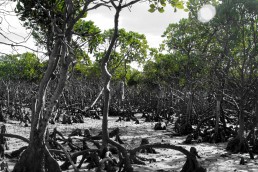
Related Case Studies
Contact
C3 MadagascarLot II PA 12 Bis, Soavinimerina, Ambohimanga Rova, Antananarivo, Avaradrano
C3 Madagascar (CONSERVATION CENTREE SUR LA COMMUNAUTE C3 MADAGASCAR), in accordance with Article No. 5 of Ordinance No. 60133, is registered as a non-profit organization in Madagascar under the Direction of the Territorial Administration of Antananarivo with Registration No. 1206/14-MID/SG/DGAT/DIRAT/ANT/ASS.
Rural Entrepreneurs
Rural Entrepreneurs
Promoting Local Livelihoods
Tailor-made training for communities.
In order to conserve coastal resources for the long term, the buy-in and motivation of local people is fundamental. C3’s focus on rural entrepreneurs addresses this challenge.
C3 has conducted business feasibility studies in conjunction with household surveys and focus group interviews to determine the best livelihoods for specific communities. Livelihoods take time to develop, especially in rural communities with a local level of education and financial literacy, we find that set-up and intensive monitoring and support is required for a three-year term to ensure that businesses are financially viable and sustainable.
C3 focuses heavily on the engagement and training of women, unemployed youth and minority groups such as the LGBT community, to provide employment opportunities close to home rather to counteract the constant emigration from rural communities to urban centres and associated ‘brain drain’.
10
Businesses yielding profits for communities, in particular women and youth, in year 3 of operation
C3’s approach focuses on year-on-year technical and financial support, refresher training, monitoring and advice for people starting new livelihoods, as it is a well-known fact that most small businesses fail in the first two years.
In only the past two years C3 established 10 new rural enterprises, with at least 50% management by women and a strong emphasis on unemployed youth. These businesses are financially viable and in particular the organic honey is yielding substantial gains for the communities on a regular basis. All our businesses are locally run with monitoring by C3 local staff. Our modus operandi is free of reliance on foreign volunteers or staff to assist with managing any aspect of these projects nor do we heavily invest in tourism; this is a deliberated decision which means we are able to continuously work at our target sites regardless of political instability and epidemics, which sadly impact Madagascar on a increasingly frequent basis.
Following our successes in assisting communities with starting up duck farming and tourism enterprises, we are now working on further apiculture training, designed to create alternative livelihoods for communities who rely on charcoal production and slash-and-burn agriculture, which have led to the alarming destruction of our dry forests in the far north. Apiculture, encouraged by the Malagasy government, has been feasibly identified as an ideal option for these communities. Already, there are women and youth associations, basic governance structures, and high levels of motivation for the project. With investment from partners and donors, C3 aims to provide the training and support for this new enterprise.
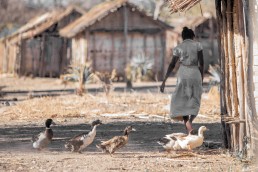
Related Case Studies
Contact
C3 MadagascarLot II PA 12 Bis, Soavinimerina, Ambohimanga Rova, Antananarivo, Avaradrano
C3 Madagascar (CONSERVATION CENTREE SUR LA COMMUNAUTE C3 MADAGASCAR), in accordance with Article No. 5 of Ordinance No. 60133, is registered as a non-profit organization in Madagascar under the Direction of the Territorial Administration of Antananarivo with Registration No. 1206/14-MID/SG/DGAT/DIRAT/ANT/ASS.
Endangered Species
Endangered Marine Species
Dugong and Sea Turtle Conservation
The sole NGO focused on sea turtle and dugong conservation in Madagascar.
The iconic yet extremely rare Dugong or sea cow and Green and Hawksbill sea turtles and sharks are key flagship species for C3’s conservation campaigns. C3 is the sole NGO focused on conserving these species in Madagascar and has been doing so for 10 years. These species have sadly been overexploited by communities for food and have succumbed as bycatch in gillnets. C3 is the primary partner in Madagascar for several Indian Ocean assessments of megafauna mortality as bycatch in artisanal fisheries and results of studies have advanced global knowledge about this issue.
Communities are engaged in outreach and monitoring programmes and C3 successfully worked with traditional leaders to ensure zero take of dugongs and sea turtles in Nosy Hara Marine Park. We work with international research teams on better understanding the status of sharks and rays at our sites and are contributing to development of a National Strategy for their conservation.
C3 has gathered traditional ecological knowledge and documented customs surrounding endangered flagship species, ensuring our integration of these aspects into contemporary conservation campaigns and materials.
We continue to monitor these populations and protect sea turtle nesting beaches across the remote north in conjunction with community volunteers and our Junior Ecoguards. Although rare, we are happy to note that dugongs are still reproducing in the north and have been spotted in aerial surveys, whereas they have become extinct from most other regions of the country. We have also identified hotspots where they regularly visit seagrass beds to feed and these have been highlighted for careful protection and monitoring.
To conserve dugongs, we work with the UNEP Global Environment Facility, Critical Ecosystem Partnership Fund, and other donors. We work with Newcastle University, and Western Indian Ocean Marine Science Association to implement fisheries research and management.

Related Case Studies
Contact
C3 MadagascarLot II PA 12 Bis, Soavinimerina, Ambohimanga Rova, Antananarivo, Avaradrano
C3 Madagascar (CONSERVATION CENTREE SUR LA COMMUNAUTE C3 MADAGASCAR), in accordance with Article No. 5 of Ordinance No. 60133, is registered as a non-profit organization in Madagascar under the Direction of the Territorial Administration of Antananarivo with Registration No. 1206/14-MID/SG/DGAT/DIRAT/ANT/ASS.
Marine Protected Areas
Marine Protected Areas
Sustainable Marine Protected Area Management
Environmental management in the remote north.
In 2014 the Malagasy government committed to tripling the area of coast covered by Marine Protected Areas in Madagascar within 10 years. C3 works with the government’s Ministry of Environment, Madagascar National Parks and communities in order to realise this vision across the remote northern region of Madagascar from Nosy Be to Vohemar.
However, we are also concerned about long-term sustainability of marine protected area management. So many MPAs are merely ‘paper parks’ and no positive impacts are being delivered on the ground in terms of fisheries management, habitat replenishment and conservation and community engagement in monitoring and management. Madagascar is so vast and with poor physical and communication infrastructure that NGOs and government cannot possibly aspire to manage coastal areas. Local communities are at the forefront of managing their own coastal areas but sadly lack the capacity, infrastructure, and basic services to get engaged in such a task.
This is where NGOs like C3 are essential; spending time in the communities, getting to know people personally and helping build their own capacity to set up management infrastructure and lead their own monitoring and decision-making. This process takes years, there is no quick fix, but once a successful model is proven, with the injection of funds and personnel, it can be replicated across vast areas as proven in the case of Nosy Hara Marine Park.
Historically donors have invested heavily in the south west of Madagascar, being an extension of some of the first terrestrial-based foreign-led conservation interventions. However, the remote northern region is recognised by all international NGOs and the Malagasy government as the last frontier of coastal biodiversity and is yet still severely underfunded. C3 works in partnership with Conservation International at ‘orphan sites’ in key biodiversity areas; places where there has been no NGO interest historically due to their inaccessibility, yet which have been proven to be the key places to invest in, due to their natural propensity for climate change resilience.
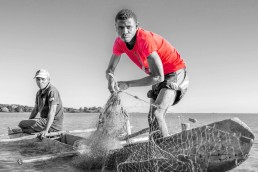
A holistic stewardship model.
C3’s innovative and successful environmental stewardship model focuses on assessing the current functioning of MPAs in a holistic manner (traditional knowledge and tabus, governance, socio-economic and biodiversity assessments, financial sustainability) and then developing community capacity for governance and implementation of management plans.
C3’s programme is the only one to ensure delivery of key community services including diversified income generation, improvements in health (e.g WASH programme) and education services, is key to ensuring MPAs benefit local populations and reducing unsustainable practices.
Sustained, intensive outreach in the communities about fisheries regulations, climate change, species and habitats is a key focal area because only by fully understanding the purpose and objectives of MPAs can the community be fully motivated and mobilised to sustain them.
One of our key successes is reducing dependence of communities solely on fishing as a source of income. Building resilience to climate change is so essential in these communities who are at the forefront of environmental disturbances such as widescale coral bleaching, severe coastal erosion, and more frequent and devastating cyclones.
C3 has now established 10 community enterprises across 5 communities and recruited and trained 30 Conservation Ambassadors, who are volunteers in their communities in charge of training and educating others in sustainable development and environmental protection. Furthermore the immensely popular youth environmental leadership programme, the Junior Ecoguards, has a cohort of more than 1500 members across 70 schools in Sava, Diana, Boeny and Sofia regions. Junior Ecoguards educate their own communities about key conservation issues and assist with practical activities such as beach clean-ups, seagrass monitoring and mangrove reforestation.
C3 assisted with provision of new and improved water pumps and water storage facilities in drought-prone areas. In conjunction, a WASH programme ensured that people were aware about correct water conservation, handling and hygiene to help prevent water-borne diseases. We also work with USAID, GIZ, UNDP and Finistere to implement our sustainable development programme.
MPAs cannot be managed in isolation of terrestrial impacts, especially in C3 Madagascar is unique in applying the Ridge to Reef approach and works with communities upstream to replant riparian vegetation and native montane forests. We partner with Conservation International, Graine de Vie, Ministry of Fisheries, Ministry of Environment and Ministry of Agriculture. We also coordinate and advise the MIHARI network in terms of providing appropriate outreach materials on endangered marine species and habitats and assisting with human resource management support.
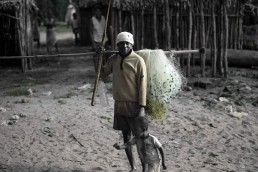
Related Case Studies
Contact
C3 MadagascarLot II PA 12 Bis, Soavinimerina, Ambohimanga Rova, Antananarivo, Avaradrano
C3 Madagascar (CONSERVATION CENTREE SUR LA COMMUNAUTE C3 MADAGASCAR), in accordance with Article No. 5 of Ordinance No. 60133, is registered as a non-profit organization in Madagascar under the Direction of the Territorial Administration of Antananarivo with Registration No. 1206/14-MID/SG/DGAT/DIRAT/ANT/ASS.


